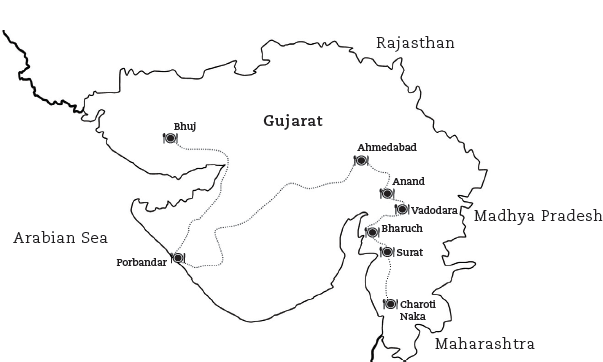GUJARAT

If there is one state in India where all is well with the local cuisine, it is Gujarat. The Gujaratis have a deep love for their food and no matter where they go in the world, they take their food with them. They should; it is amazing. Gujarati food can be divided into four distinct ‘major’ cuisines (there are several others, so this is not an exhaustive list). The Kuchhi, which is the food of the Rann of Kutch - this is the great salt desert of Gujarat and the dry arid areas around it. Hearty Rotlas (Breads made with millet etc. ), cooling Chaas (Buttermilk), salty and spicy khichdis (rice and lentil mixes), and local seasonal vegetables starting with the ever popular Ringda (Aubergine) and going onto whatever is grown in this harsh land. They love their chilli and spice, and food cooked using natural fuels adds a strong rustic flavour to this cuisine.
The Kathiawadi is the spiciest cuisine of Gujarat and if you thought that all Gujarati food was sweet, this is the cuisine that dispels this myth rapidly. Sev Tamatar (Sev is a dry snack prepared with Chickpea and Lentil flour which is cooked in a Tomato gravy with heavy spice and chilli) and Kadhi (Buttermilk and yoghurt gravy) stand out here for us. A rich and varied cuisine, it is ideal for the hot terrain of Gujarat. This is a cuisine that once tasted, is not easily forgotten.
The Gujarati is a term combining an embarrassing wealth of cuisines and bringing them together. This is where that sweet touch in spicy food is dominant and this is perhaps the cuisine that best represents this state. The mighty Undhiyu (a mixed vegetable ball of goodness), amazing Khichdi’s, spicy gravies, and an unending range of preparations makes this cuisine stand out.
Gujarat is possibly best known for its snacks across the rest of the country and Surti cuisine or the cuisine of Surat has arguably the best snacks. Here are a few names: Handvo, Surat nu Locho, Khandvi, Dhokla, Thepla, Patra, Muthia, and the list is endless. The people of Surat claim to have the best food in the world and they may be right. The saying, “Surat nu Jaman ane Kashi nu Maran” brings their worldview together really well. It means to be born and to eat in Surat and to die in Kashi (Banaras) are heavenly experiences and will uplift your soul to the heavens. Who are we to argue? Our favourite snacks, the Dhabeli and the Bhakarvadi, are both best made in Gujarat.
NAVRATRI
During Navratri (nine nights), open stalls and pushcarts all over the city serve a savoury snack called Papdi No Loat. A pretty healthy morsel, it’s traditionally prepared in home kitchens through the year, but during the festival, it’s everywhere. It’s steamed rice flour dumplings spiced with a mixture of zeera (cumin) and ajwain (carom) along with salt and green chilli paste. Best eaten piping hot, it’s seasoned primarily with oil and red chilli powder and usually chopped into bite-sized chunks. Served in traditional pattal (dried leaves) dishes and eaten using wooden toothpicks/shards, the Loat is a true blue taste of India!
SOMETHING ON THE SIDE
Navratri is dedicated to the worship of the nine forms of the Divine feminine power—Shakti (or Devi). It’s celebrated with great fervour and zeal at the beginning of Spring and Autumn, especially in Gujarat and Maharashtra. Men and women of all ages wearing bright coloured and embellished (beads, shells, mirrors, stars, embroidery etc. ) costumes spend the nine nights dancing the Garba to honour the Goddess. The Garba involves rings of dancers revolving in cycles and performing a series of intricate dance steps. The music is either very traditional (live music and traditional instruments) or mixed with popular Bollywood beats. Venues include neighbourhood localities, colleges, and large parks where people decked out in funky costumes come from all over the state/country/world to dance together and celebrate. The United Way Garba party had 42, 000 dancers loving life—one step at a time!
Doing the Garba is not as easy as it looks,
You can have a few twirls while the Papdi No Loat cooks.
United Way, a 100 other places, and a College that is arty,
No matter where you go in the world, this is the biggest dance party!
RANN UTSAV
Full moon night in December is the best time to visit the Rann of Kutch, one of Gujarat’s most ecologically and ethnically diverse districts. The Rann (‘salt marsh’) is reputed to be the largest desert of its kind in the world and full moon is the perfect time to experience the unforgettable sight of the white Rann glinting like a sheet of diamonds as moonlight reflects off the salt crystals.
The Rann Utsav is a 3-day cultural extravaganza organised by Gujarat Tourism. This is a fantastic opportunity to spend a few nights in comfortable desert tents and enjoy spirited folk music and dance performances, handicrafts, camel rides, and some amazing organic Kutchhi food. Besides traditional experiences, you can also enjoy adventure sports including hair-raising rides on ATVs (All-Terrain Vehicles). Take a jeep safari to explore the region or jump onto a hot air balloon to get a bird’s eye view of this amazing landscape, which is a birdwatcher’s delight and also one of India’s largest wildlife reserves.
I didn’t have any Butter Chicken and there was no ‘Daaru Ka Thekaa’ (Liquor Shop), But ‘Kutch Nahin Dekhaa toh Kuch Nahin Dekhaa’ (you ain’t seen nothing if you ain’t seen Kutch).
Art and Culture and 2 wild rides,
Is the Kutch sand or salt? You decide!